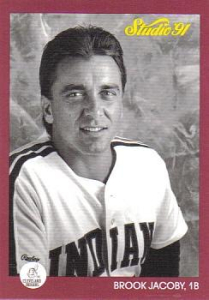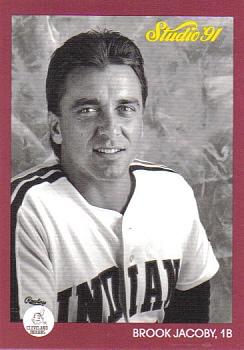April 15, 1991: Brook Jacoby’s home run delivers 13-inning Patriots Day win for Cleveland
 Patriots Day commemorates the Revolutionary War Battles of Lexington and Concord on April 19, 1775. Massachusetts and a handful of other states recognize it as a holiday on the third Monday in April.
Patriots Day commemorates the Revolutionary War Battles of Lexington and Concord on April 19, 1775. Massachusetts and a handful of other states recognize it as a holiday on the third Monday in April.
Greater Boston celebrates Patriots Day with several annual events.1 In Lexington, there is a parade and reenactment of the first skirmish on the Lexington Battle Green, but perhaps the day’s biggest attraction is the running of the Boston Marathon. The world’s largest annual marathon has been a part of Patriots Day since 1897. The event draws competitors and spectators from around the globe.
Another popular event is attending a baseball game. Starting in 1904 the Boston Beaneaters (later the Braves) and the Boston Americans (later the Red Sox) alternated home dates, with the National League Braves playing in even-numbered years and the Red Sox in the odd.2
After the Braves relocated to Milwaukee in 1953, the Red Sox have hosted the game, with a customary late-morning start. Of course, there have been a sprinkling of rainouts, a players strike in 1995, and the pandemic in 2020 that caused Fenway Park to go dark.3
On April 15, 1991, the Cleveland Indians joined the party, as they wrapped up a four-game set with the Red Sox. Cleveland had won two of the first three games in the series. In Sunday’s game, Cleveland knuckleballer Tom Candiotti pitched seven innings of shutout baseball, striking out nine and improving his record in the young season to 2-0. Albert Belle, at age 24 back in the Indians’ lineup after spending two months of the 1990 season in an alcohol rehabilitation program, hit two home runs and drove in four runs.
Boston (88-74) had won the AL East Division title in 1990, only to be swept by the Oakland A’s in the ALCS. It was the same fate that had befallen the Red Sox in 1988: winning the East, then getting swept by Oakland in the ALCS. They were off to a slow start in 1991, losing two of three against the Toronto Blue Jays before dropping two of three to Cleveland.4
Cleveland (77-85) finished in fourth place in the AL East in 1990. Unlike the Red Sox, who were expected to compete for a division crown on a yearly basis, ending the season in fourth was about as close to nirvana as the Indians got. It matched their best finish in the AL East since the two-division format was instituted in 1969.5
The pitching matchup was right-handed Charles Nagy (0-1, 1.12 ERA) for the visitors and southpaw Matt Young (0-0, 3.60 ERA) for Boston. Each was making his second start of the season. Nagy, a native of Bridgeport Connecticut, was pitching before family and friends.
From the 11:05 A.M. first pitch onward, both pitchers were on top of their game. While both teams put runners on base, neither was successful in scoring runs. Two double plays helped Nagy avoid potential jams. Young walked three batters, but no Cleveland baserunner reached third base.
With the game still scoreless, Boston designated hitter Jack Clark, an offseason free-agent signing, led off the fifth with a walk. He advanced to third base when Ellis Burks connected for his fifth double of the season off the left-field wall.
Red Sox right fielder Mike Marshall tapped a grounder to the left of third. Cleveland’s Jeff Manto fielded the ball and threw to catcher Joel Skinner to nail Clark. Burks did not advance on the play, and Nagy retired the next two batters to get out of the inning.
“The third base coach [Dick Berardino] told Clark not to go,” said Manto, “but I think he thought he could make it because the ball was hit to my left. But [shortstop] Felix [Fermin] was yelling for me to go home and the ball hit just hard enough.”6
Cleveland put its leadoff batter on first base via walks in the sixth and seventh innings. But the Indians were unable to manufacture a run from Young’s generosity. Similarly, Boston was having difficulty getting anything started against Nagy. He had been the beneficiary of three double plays, a pitcher’s best friend, in seven innings.
In the bottom of the ninth, with Nagy still on the mound, the Red Sox attempted to push across the winning run. Wade Boggs led off with a walk. Jody Reed sacrificed Boggs to second base. Mike Greenwell was given an intentional walk to put runners on first and second.
Cleveland manager John McNamara – who had managed the Red Sox from 1985 through the middle of the 1988 season – went to his bullpen and summoned submarine-style pitcher Steve Olin. Clark was the first batter he faced, and the right-handed slugger bounced into a 1-4-3 double play.
The game went into extra innings. Right-handed reliever Jeff Gray replaced Young. With one down in the top of the 10th, center fielder Mike Huff singled to center field. Huff then swiped second base, his first steal of the season. But Huff stayed put as Fermin flied out to center and Mitch Webster lined out to right field.
Cleveland got a baserunner as far as second base in the 11th and 12th innings but could not get the big hit when it was needed the most. Meanwhile. Olin set the Red Sox down in order in the 10th, 11th, and 12th innings.
It may have dawned on those in attendance that there was another marathon taking place in Boston, and the route always passes through Kenmore Square, more or less two blocks from Fenway Park. Neither team was able to capitalize when scoring opportunities presented themselves. It seemed as if the game might go on for a while.
Dennis Lamp emerged from the Red Sox bullpen at the start of the 13th inning. The 38-year-old righty, pitching in his 15th major-league season, retired Belle on a fly out to start off the top of the inning. Then Brook Jacoby pounded Lamp’s first pitch into the screen above the left-field wall for a solo home run. The blast was Jacoby’s first of the year. Lamp settled down and set the Indians down in order. But the Tribe led, 1-0.
McNamara called on reliever Doug Jones to shut the door on Boston. Burks grounded out to short to begin the inning. Tom Brunansky pinch-hit for Kevin Romine and did his part, lacing a single to left field.
Carlos Quintana followed, and he also singled to left field to put runners on first and second with one out.
Tony Peña grounded out to third base for the second out as Brunansky moved to third. Jones then got Tim Naehring to pop out to second baseman Jerry Browne to preserve the 1-0 Cleveland victory.
Jacoby’s home run had accounted for all of the scoring. “Whenever I try to pull the ball here, I end up grounding out to first,” said Jacoby, who was in his eighth season with Cleveland, making him the longest-tenured member of the Indians’ roster.
“I don’t even look at the wall. There’s a right field in Fenway, too, and I try to use it. I was just looking for a pitch to hit hard. It was a fastball that was down, but not in and I hit it hard. I knew it would be at least off the wall.”7
Both starters had control issues, which is not uncommon at the beginning of the season. But otherwise, both Young and Nagy made the pitches they needed to get out of trouble. Young threw 133 pitches in nine scoreless innings. He gave up two hits and six walks and struck out four.8 Nagy, who threw 124 pitches, went 8⅓ innings, surrendered four hits, struck out four, and walked five. “Charles Nagy has arrived,” said McNamara.9
Cleveland’s season, with so much promise, hit the skids. Candiotti was traded to Toronto on June 27. McNamara was fired on July 5 and replaced with Mike Hargrove. Huff was waived and picked up by the White Sox on July 12, and Jacoby was sent packing to Oakland on July 26. Injuries, specifically to catcher Sandy Alomar Jr. and pitcher Eric King, curtailed the team’s progress. As a result, Cleveland (57-105) finished in last place in the AL East. Nagy’s 10 wins led the pitching staff.
Boston (84-78) finished tied for second place with the Detroit Tigers, seven games behind Toronto. The Red Sox won eight of their next nine games against Cleveland and were 9-4 against the Indians in 1991.
Acknowledgments
This article was fact-checked by Ray Danner and copy-edited by Len Levin. The author would like to thank Bill Nowlin for his help with this article.
Sources
In addition to the sources cited in the Notes, the author consulted Baseball-Reference.com and Retrosheet.org for pertinent information, including the box score and play-by-play.
https://retrosheet.org/boxesetc/1991/B04150BOS1991.htm
https://www.baseball-reference.com/boxes/BOS/BOS199104150.shtml
Notes
1 Boston USA, “Boston Patriots’ Day Events,” Bostonusa.com, accessed January 18, 2023, https://www.bostonusa.com/events/holidays/patriots-day/.
2 Bill Nowlin, Red Sox Threads: Odds & Ends from Red Sox History (Burlington, Massachusetts, 2008), 289-90.
3 Nowlin.
4 Boston’s only two wins of the season were by Roger Clemens, who went on to win his third AL Cy Young Award in 1991.
5 Cleveland also finished in fourth place of the AL East from 1974 to 1976.
6 Paul Hoynes, “Indians Win in 13, 1-0,” Cleveland Plain Dealer, April 16, 1991: 2-E.
7 Hoynes.
8 Nearly a year to the day later, on April 12, 1992, Young threw eight no-hit innings against the Indians in Cleveland but walked seven and lost the game, 2-1.
9 Hoynes, 1-E.
Additional Stats
Cleveland Indians 1
Boston Red Sox 0
13 innings
Fenway Park
Boston, MA
Box Score + PBP:
Corrections? Additions?
If you can help us improve this game story, contact us.


